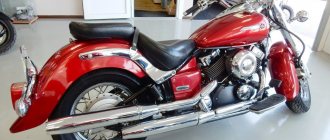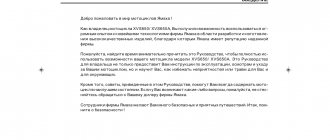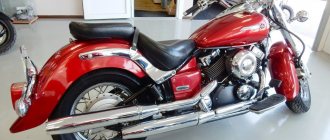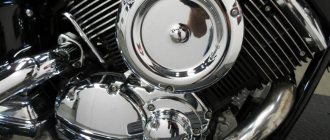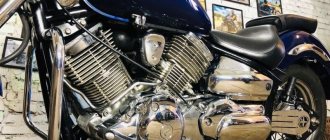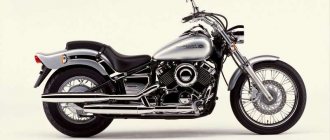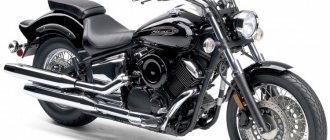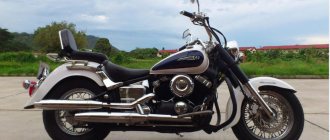Mid-sized cruisers are not particularly popular among domestic chopper drivers, and they, having saved money, with the words “anything less than a liter is not a chopper,” are switching from their first “four hundred” to “one and a half liters” and more. The middle segment remains the lot of young ladies and “pensioners,” but in vain.
STORY . Yamaha XVS650 Drag Star became the successor to the “honored witch of all Japan” - XV535 Virago in 1997. Unlike its predecessor, the Star was no longer a timid attempt to make a motorcycle in the American style - the Japanese had already accumulated experience in creating this kind of equipment. Low, elongated frame, rear suspension a la “softail” with a monoshock absorber hidden in the depths of the frame, teardrop-shaped tank, stepped saddle, tidy on the tank, a lot of chrome... In general, you can’t complain. But the engine on the “drag” is already familiar: a 75-degree four-valve V-twin from the same “Viraga”, only slightly modernized in appearance and “grown” to 649 “cubes” due to an increase in cylinder diameter by 5 mm and by 4 - piston stroke. With the same compression ratio of 9:1, the updated engine has become more “chopper-like”, that is, less revving, but more torquey. Compared to the Virago, the power even decreased from 42.3 hp. at 7500 rpm up to 40 hp. at 6500 rpm, the torque, on the contrary, increased, and its peak “fell” by as much as “half a tachometer”: from 46 Nm at 6000 rpm to 50.9 Nm at 3000 rpm.
Otherwise, there are no high-tech and modernistic trends alien to cruisers: a disc brake in the front, a drum in the rear, a carburetor power system, which, by the way, has not yet been replaced with injection, and other technical solutions that are simple and reliable as a hammer. The motorcycle created according to this simple “recipe” turned out to be extremely reliable, comfortable, easy to operate and maintain and, of course, got its own piece of the consumer “pie”, which it is still “chewing” to this day. True, this happens mainly not in Russia, but in countries where motorcyclists suffer from “lithromania” in a less advanced form.
FOR WHAT? Conversations about the purpose of any cruiser always end in controversy. Fans extol the comfort and relaxation of the landing; opponents point to the weakness of the engines, the weakness of the chassis and the inconvenience of maneuvering in city traffic. Both are true, but in relation to the Drag Star 650, all arguments are only partially applicable. Although 40 “horses” look rather dull, in fact they “carry” a 225-kilogram motorcycle quite vigorously. The low center of gravity of the motorcycle itself and the rather low saddle (695 mm) make it easy to shift the motorcycle in turns and not only for “big pot-bellied guys,” but also for petite girls to feel confident in the grip of traffic jams. By the way, it is precisely thanks to this feature that in Russia “drag” is so popular among the fair sex. It looks large and “cast iron”, but in reality it is a light and obedient device. It is precisely due to its light weight, low center of gravity and relatively compact dimensions that the 650 feels much more at ease in the city than all kinds of VTX, Boulevard and other “mastodons”. The device is also quite good as a route tool. A relaxed landing, soft suspension and excellent directional stability make long-range driving quite comfortable, although not fast.
WHERE TO LOOK? There are plenty of offers for sale, both from private owners selling devices that have already traveled around Russia, and from companies transporting equipment “from there”. “drag” can be found in almost any salon selling second-hand goods. Unlike most entry-level and mid-level models, the vast majority of dragstars are in fair, and often truly perfect, condition. The reason for this is the reliable design and the almost complete ignorance of the model by beginners. So you shouldn’t avoid vehicles with mileage in Russia. It’s quite difficult to come across blatant trash. Moreover, a device from “Russian” hands can be a more profitable purchase than one freshly imported from Japan or the States. The technical condition may be no worse, and the price may be more attractive. The price range for motorcycles is quite wide. From 170–195 thousand rubles. for copies of the first years of production up to 300–320 thousand rubles. for almost new one-year-old - three-year-old specimens. In part, the price depends on the amount of tuning, but, as a rule, the bulk of the devices have a similar set: panniers, a windshield, arches and various “tchotchkes” that do not affect speed and comfort. So you shouldn’t consider the presence of any of the above as a serious reason for raising the price. There should be no issues with selling a used device. There is always a stable demand for it. Naturally, taking into account cruiser specifics. Unlike enduro or even 400 classics, appearance for a custom car is far from the last thing, so traces of falls, scuffs and scratches on chrome and paint seriously reduce both the marketability of the device and its price. It will be difficult to sell the motorcycle at the end of the season. Potential buyers of the “drag” are most often people of average income and by the end of the season are not burdened with an extra two hundred thousand rubles. And a chopper is not an enduro to buy in winter.
WHAT TO WATCH FIRST AND WHAT TO FOLLOW LATER?
(+) From a technical point of view, the motorcycle can be classified as practically problem-free. There are not many motorcycles without “family diseases”, and the Drag Star is one of them. There are several reasons for this. Firstly, the refined design of the engine and transmission, which is based on the Virago power unit, is simple and long ago “cured” of all infantile shortcomings. Secondly, the relative freshness of the model and far from exorbitant popularity. The device very rarely reaches people with crooked hands and a hot head. So all checks when choosing a motorcycle can be reduced to a standard diagnostic list: timing noise, freshness of consumables, tightness of shock absorbers and checking frame geometry. By the way, the system for adjusting timing valve clearances here is a common one - a screw-nut, so there will be no difficulties with adjustment.
(+) Unlike the older model XVS1100 Drag Star, the “six hundred and fifty” is practically not subject to slipping of the starter overrunning clutch, so a slightly different design is used here, but even if the defect does come out, the part costs half as much as the similar one from the 1100.
(!) The design of the average “drag” is almost identical to the internal Japanese “400” (only the size of the cylinders, gearbox ratios and other minor details differ), so you can extrapolate some of the defects of the “400”. Since there are many more of them in Russia, more extensive statistics have been collected on them. So, sometimes on the XVS400 the driveshaft breaks, the starter overrunning clutch fails, and the voltage regulator relays burn. However, all these defects can be attributed not to the weakness of the design, but to improper operation and lack of timely maintenance of the equipment. In general, if the motorcycle has not been damaged by its previous owners, then with proper care it will work without problems for many years.
Yamaha Drag Star 400 design
The design of the bike is based on a classic duplex steel frame.
Since the model is a replacement for the outgoing one, the developers had no questions with either the type or the material of the main design.
A duplex steel frame was used for the motorcycle. The design made it possible to achieve good maneuverability and controllability, and the steel provided the necessary rigidity.
Until 2008, the engine was an old one, which was retuned, and later, in 2009, a new, injection one was installed, which led to a change in almost all overall dimensions, and not just one fuel supply system.
The developers decided to save money on the suspension . The layout is standard, and there is even rear spring preload adjustment . But unlike the prototype, there is only one shock absorber . Other changes are minimal.
A telescopic fork holds the front wheel, and a swingarm holds the rear wheel. The working strokes are respectively 140 mm and 86 mm.
Exterior
As you know, the appearance of a cruiser cannot be called ordinary. And if you consider that the 400 had a model in front of it - a liter model of the same name, the questions disappear completely.
Drag Star is impressive with its appearance - the Japanese have long learned to play on our weaknesses.
Front end
- The bike has a small front fender that is pressed tightly against the tire . The fork legs are bare - except for the part along the wheel. Motor protection from dirt is at the highest level. At the front, a plate covers from the bottom to the junction of the frame and the fork; underneath it, the same one is laid almost to the rear wheel. Both are connected to each other.
The front of the motorcycle is made in the spirit of classic cruisers.
- The head optics are made in the form of a round headlight . It's big and shines well. The turn indicators are standard - placed on the fork legs just below the main one. There is no windshield.
- Handlebar mirrors. Large, square, but due to the fact that it is tilted towards the motorcyclist, they do not provide a good overview.
The steering wheel is high, with comfortable handles and clearly working lighting control buttons.
Dashboard
Like any self-respecting cruiser, the panel is located on the gas tank. The set is not large, and is also limited by the size of the upper part.
The elegant dashboard is located directly on the wide gas tank.
One dial is a speedometer and a row of indicators. In 2009, a fuel gauge appeared.
The speedometer is marked up to 180 km/h . Among the indicators:
Rear view
The direction indicators in their own cups are located outside the bike . The stop/marker is mounted at the end of the stem, so it is clearly visible. Place a number on the symbolic mudguard. According to users, if you want to play hide and seek with the traffic police, you can drive through a small puddle and the number will be closed.
The rear light housing is recessed inside the plastic body kit.
Double saddle . In pursuit of comfort, the developers extended it from the gas tank, almost to the end of the frame, while bending it figuratively under it. However, there is a small space left behind for those who like to install panniers.
The seat is soft and very comfortable, providing the most comfortable fit.
Yamaha V Star 1100 Classic 2008
| basic information | |
| Model: | Yamaha V Star 1100 Classic |
| Year: | 2008 |
| Type: | Chopper / Custom / Cruiser |
| Motor and drive | |
| Working volume: | 1065 cm3 |
| Type: | V2 |
| Bars: | 4 |
| Compression: | 8.3:1 |
| Bore x Stroke: | 95.0 x 75.0 mm (3.7 x 3.0 inches) |
| Fuel system: | Carburettor. (2) 37mm Mikuni w/throttle position sensor |
| Bore x Stroke: | 95.0 x 75.0 mm (3.7 x 3.0 inches) |
| Fuel control: | SOHC |
| Engine starting: | Electric starter |
| Ignition: | TCI |
| Cooling: | Air |
| Transmission: | 5 speed |
| Drive unit: | Cardan |
| Dimensions | |
| Weight: | 272.2 kg |
| Height: | 1100 mm |
| Length: | 2464 mm |
| Width: | 945 mm |
| Ground clearance: | 140 mm |
| Seat height: | 709 mm |
| Chassis | |
| Wheelbase: | 1646 mm |
| Frame: | Steel; hidden shock |
| Front shock absorber: | Telescopic fork |
| Front travel: | 140 mm |
| Rear shock absorber: | Single shock |
| Rear travel: | 114 mm |
| Colors: | Pearl White, Raven w/flames |
| Other | |
| Gas tank capacity: | 17.03 l. |
| Front tire: | 130/90-16 |
| Rear tire: | 170/80-15 |
| Front brake: | Double disc |
Background [edit]
Based on the Yamaha Virago 535 engine, XVS650 cylinders (named V Star in the US and Australia)
were bored a further 5 mm to 81 mm and offset by 4 mm to 63 mm, resulting in engine capacity of 649 cc. The XVS650 comes in two models: Custom with a lower seat height of 695 mm (27.4 in) and slightly lighter weight, and Classic with a higher seat height of 708 mm (27.9 in). The Custom weighs approximately 232 kg (511 lb), while the Classic is approximately 15 kg heavier at 247 kg (545 lb).
The Yamaha XVS650 is sold in the US as the entry-level version of the V-Star line. This line was offered from 1998 to 2008 in two different versions: Classic and Silverado. Both versions are built around the same 649 cc V-Twin engine. The V-Star line offers the visual appeal of a large V-twin with the fuel efficiency, reliability and agility of a midsize cruiser.
Yamaha DS11 Drag Star Eleven 1100
| basic information | |
| Model: | Yamaha DS11 Drag Star Eleven 1100 |
| Year: | 2011 |
| Type: | Chopper / Custom / Cruiser |
| Motor and drive | |
| Working volume: | 1063 cm3 |
| Type: | V2, four-stroke |
| Power: | 60.35 hp (44.1 kW)) @ 5750 rpm |
| Compression: | 8.3:1 |
| Bore x Stroke: | 95.0 x 75.0 mm (3.7 x 3.0 inches) |
| Torque: | 82.00 Nm (8.4 kgf-m / 60.5 ft.lbs) @ 2500 rpm. |
| Fuel system: | Carburettor. BSR37 |
| Valves: | 2 |
| Bore x Stroke: | 95.0 x 75.0 mm (3.7 x 3.0 inches) |
| Fuel control: | SOHC |
| Engine starting: | Electric starter |
| Ignition: | TCI Formula |
| Engine lubrication: | Wet sump |
| Cooling: | Air |
| Transmission: | 5 speed |
| Clutch: | Wet multiple plate coil springs |
| Dimensions | |
| Weight: | 262 kg |
| Height: | 1100 mm |
| Length: | 2405 mm |
| Width: | 895 mm |
| Seat height: | 690 mm |
| Chassis | |
| Wheelbase: | 1640 mm |
| Frame: | Double cradle |
| Fork angle: | 33.0° |
| Trail: | 136 mm |
| Speed and acceleration | |
| Power/Weight: | 0.2303 hp/kg |
| Other | |
| Gas tank capacity: | 17 l. |
| Front tire: | 110/90-M18 |
| Rear tire: | 170/80-M15 |
| Front brake: | Double disc |
| Rear brake: | Single disc |
| : | Sold in Japan. |
XVS1100 Drag Star 1100 Custom
| Years of manufacture | 1998 to today for the American and Japanese markets. |
| Engine | |
| Volume | 1063 cm3 |
| Timing | SOHC |
| Type | 75° V2 |
| Bore and stroke | 95 x 75 mm. |
| Compression ratio | 8,3:1 |
| Compression | 1000 kPa (10 kg/cm2, 10 atm.) at 400 rpm |
| Cooling | Air |
| Number of gears | 5 |
| Clutch type | Multi-disc in oil bath |
| Power | 63 hp at - 5750 rpm. |
| Moment | 85 Nm at 2500 rpm. |
| Dimensions | |
| Length | 2405 mm. |
| Width | 894 mm. |
| Base | 1641 mm. |
| Seat height | 691 mm. |
| Overall height | 1095 mm. |
| Ground clearance | 145 mm. |
| Dry weight | 259 kg. |
| Miscellaneous | |
| Volume of the tank | 17 l. of which 4.5 liters. reserve |
| Wheels | front 110/90-18, rear 170/80-15 |
| Rear wheel drive | cardan shaft |
| Brakes | front double-disc 298 mm, rear single-disc 282 mm |
| Acceleration up to 100 km/h. | 5.2 c. |
| Engine | 1063 cm3, 4-stroke, 2-cylinder, V-twin, SOHC, 4 valves, air cooling |
| Maximum power | 62 hp at 5750 rpm |
| Maximum torque | 84 Nm at 2500 rpm |
| Length | 2465 mm |
| Base | 1640 mm |
| Dry weight | 278 kg |
| Front tire | 110/90-18 |
| Rear tire | 170/85-15 |
Specifications
| Motorcycle type | Cruiser |
| Start of release | Since 1997 |
| Engine | V-shaped, four-stroke, two-cylinder |
| Transmission | Mechanical, 5-speed |
| Drive unit | Cardan |
| Front wheel size | Classic - 130/90-16M/C (67S) Custom - 100/90-19M/C (57S) |
| Rear tire | 170/80-15M/C (77S) |
| Brakes | Front - disc, two-piston caliper Rear - drum |
| Height | Classic – 1105 mm Custom – 1065 mm |
| Width | Classic – 930 mm Custom – 880 mm |
| Length | Classic – 2450 mm Custom – 2295 mm |
| Wheelbase size | Classic – 1625 mm Custom – 1610 mm |
| Fuel tank capacity | 16 liters, plus a reserve of 3 liters |
| Motorcycle weight | Classic – 247 kg Custom – 227 kg |
The Yamaha Drag Star 650 cruiser is equipped with a V-twin engine with a power of 40 horsepower and a displacement of 649 cubic centimeters.
The engine installed on the bike is simple and long ago “cured” of all its shortcomings.
The maximum speed to which the bike can accelerate is 147 kilometers per hour. It can accelerate to the first hundred in 7.3 seconds.
- The front suspension is made in the form of a 41 mm telescopic fork, with a stroke of 140 mm .
- At the rear , a pendulum suspension with a monoshock absorber is used. The stroke is 98 mm .
Fuel consumption
The motorbike consumes approximately 5.35 liters per 100 kilometers.
Therefore, the chopper can be called economical. When taking into account gasoline consumption, it is necessary to take into account driving style. For example, aggressive driving will consume much more fuel. If you need to use gasoline economically, it is better to move smoothly and carefully, do not give too much gas and do not make sudden braking.
To refuel a motorcycle, it is best to use AI-95 .
Front roll bars.
Additional lights.
Rear fender rack.
DSC11 Drag Star Eleven Classic
| basic information | |
| Model: | Yamaha DSC11 Drag Star Classic Eleven 1100 |
| Year: | 2011 |
| Type: | Chopper / Custom / Cruiser |
| Motor and drive | |
| Working volume: | 1063 cm3 |
| Type: | V2, four-stroke |
| Power: | 60.35 hp (44.1 kW)) @ 5750 rpm |
| Bore x Stroke: | 95.0 x 75.0 mm (3.7 x 3.0 inches) |
| Torque: | 82.00 Nm (8.4 kgf-m / 60.5 ft.lbs) @ 2500 rpm. |
| Fuel system: | Carburettor. BSR37 |
| Valves: | 2 |
| Bore x Stroke: | 95.0 x 75.0 mm (3.7 x 3.0 inches) |
| Fuel control: | SOHC |
| Ignition: | TCI |
| Cooling: | Air |
| Transmission: | 5 speed |
| Clutch: | Wet multiple plate coil springs |
| Dimensions | |
| Weight: | 275 kg |
| Height: | 1100 mm |
| Length: | 2460 mm |
| Width: | 950 mm |
| Seat height: | 710 mm |
| Chassis | |
| Wheelbase: | 1640 mm |
| Frame: | Double cradle |
| Fork angle: | 33.0° |
| Trail: | 132 mm |
| Speed and acceleration | |
| Power/Weight: | 0.2195 hp/kg |
| Other | |
| Gas tank capacity: | 17 l. |
| Front tire: | 130/90-16 |
| Rear tire: | 170/80-15 |
| Front brake: | Double disc. Hydraulic |
| Rear brake: | Single disc. Hydraulic |
| : | Sold in Japan. |
Brief history of the model
- 1997 - start of production and sales of Yamaha Drag Star 650.
Model
: Yamaha Drag Star 650 (Europe).
Factory designation
: 4VR2, 4XP1, 4XP2, 4XR1, 4XR2.
- 1998 - the appearance of the Yamaha Drag Star 650 Classic modification, the start of sales in the North American market.
Model
: Yamaha Drag Star 650, Yamaha Drag Star 650 Classic, Yamaha V-Star 650 Custom, Yamaha V-Star 650 Classic (Europe, North America).
Factory designation
: 4VR3, 4VR4, 4VR5, 4VR6, 4XP3, 4XP4, 4XR3, 4XR4, 4XR5, 4XR6, 5BN1, 5BN2, 5BN3, 5BN4, 5BN5, 5BN8, 5BN9, 5FB1, 5FB2, 5FB3, 5FB6.
- 1999 - no significant changes.
Model
: Yamaha Drag Star 650, Yamaha Drag Star 650 Classic, Yamaha V-Star 650 Custom, Yamaha V-Star 650 Classic (Europe, North America).
Factory designation
: 4RX8, 4VR7, 4VR8, 4VR9, 4VRA, 4XR7, 4XR8, 4XR9, 4XRA, 5BNA, 5BNB, 5BNC, 5BND, 5BNE, 5BNF, 5BNG, 5FB7, 5FB8, 5FB9.
- 2000 - no significant changes.
Model
: Yamaha Drag Star 650, Yamaha Drag Star 650 Classic, Yamaha V-Star 650 Custom, Yamaha V-Star 650 Classic (Europe, North America).
Factory designation
: 4VRB, 4VRC, 4XRB, 4XRC, 5BNJ, 5BNK, 5BNL, 5BNM, 5BNN, 5BNP, 5BNR, 5FBA, 5FBB, 5FBC.
- 2001 - no significant changes.
Model
: Yamaha Drag Star 650, Yamaha Drag Star 650 Classic, Yamaha V-Star 650 Custom, Yamaha V-Star 650 Classic (Europe, North America).
Factory designation
: 4VRD, 4XRD, 5BNT, 5BNU, 5BNV, 5BNW, 5BNX, 5FBD, 5FBE, 5FBF.
- 2002 - no significant changes.
Model
: Yamaha Drag Star 650, Yamaha Drag Star 650 Classic, Yamaha V-Star 650 Custom, Yamaha V-Star 650 Classic (Europe, North America).
Factory designation
: 4VRE, 4XRE, 5FBG, 5FBH, 5FBJ, 5SC1, 5SC2, 5SC3, 5SC5, 5SC6.
- 2003 - appearance of the Silverado modification.
Model
: Yamaha Drag Star 650 Silverado, Yamaha V-Star 650 Custom, Yamaha V-Star 650 Classic, Yamaha V-Star 650 Silverado (Europe, North America).
Factory designation
: 5FBK, 5FBL, 5FBM, 5SC7, 5SC8, 5SC9, 5SCB, 5SCC, 5SCD.
- 2004 - no significant changes.
Model
: Yamaha Drag Star 650 Silverado, Yamaha V-Star 650 Custom, Yamaha V-Star 650 Classic, Yamaha V-Star 650 Silverado (Europe, North America).
Factory designation
: 5FBN, 5FBP, 5FBR, 5SCE, 5SCF, 5SCG, 5SCJ, 5SCK, 5SCL, 5SCM.
- 2005 - appearance of the Midnight modification.
Model
: Yamaha Drag Star 650 Silverado, Yamaha Drag Star 650 Classic, Yamaha V-Star 650 Custom (+ Midnight), Yamaha V-Star 650 Classic, Yamaha V-Star 650 Silverado (Europe, North America).
Factory designation
: 3B61, 3B62, 3B63, 5FBS, 5FBT, 5FBU, 5SCN, 5SCP, 5SCR, 5SCT, 5SCU, 5SCV, 5SCW, 5SCX.
- 2006 - no significant changes.
Peculiarities
Despite the fact that the motorbike has a fairly modern filling, it is still equipped with a carburetor engine . The five-speed manual transmission shifts only using a foot switch.
- The drive wheel is driven by a cardan shaft.
No problems with the chain, since there is simply none here. Editorial bike!
- The power unit and gearbox are installed on high-strength steel frame created in the form of a tubular structure. It is worth noting that it is made in the style of Harley Davidson. Special stays protect the front telescopic fork on which the headlight is located.
The classic version has a wider front wheel, a long fender and a headlight without a visor. Editorial bike!
- The turn signals are installed just below it. An interesting design feature of the motorcycle is that the shock absorber at the rear is installed directly under the rear passenger seat .
Yamaha Drag Star 650 has a reliable braking system. It has two brake discs at the front and a drum at the rear.
Due to the long wheelbase, the main load during braking falls on the rear drum. Editorial bike!
